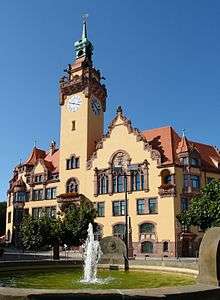Waldheim, Saxony
| Waldheim | ||
|---|---|---|
|
Town center | ||
| ||
 Waldheim | ||
Location of Waldheim within Mittelsachsen district  | ||
| Coordinates: 51°4′N 13°1′E / 51.067°N 13.017°ECoordinates: 51°4′N 13°1′E / 51.067°N 13.017°E | ||
| Country | Germany | |
| State | Saxony | |
| District | Mittelsachsen | |
| Municipal assoc. | Waldheim | |
| Government | ||
| • Mayor | Steffen Blech | |
| Area | ||
| • Total | 41.62 km2 (16.07 sq mi) | |
| Population (2015-12-31)[1] | ||
| • Total | 9,082 | |
| • Density | 220/km2 (570/sq mi) | |
| Time zone | CET/CEST (UTC+1/+2) | |
| Postal codes | 04736 | |
| Dialling codes | 034327 | |
| Vehicle registration | FG | |
| Website | www.stadt-waldheim.de | |
Waldheim is a town in Mittelsachsen district, in Saxony, Germany.
Geography
It is situated in the valley of the Zschopau River, 9 km (5.6 mi) southwest of Döbeln, and 28 km (17 mi) north of Chemnitz. The municipal area comprises Waldheim proper, the localities of Reinsdorf, Massanei, Heiligenborn, and Schönberg, as well as parts of the former Ziegra-Knobelsdorf municipality with the localities of Gebersbach, Heyda, Knobelsdorf, Meinsberg, Neuhausen, and Rudelsdorf, which were incorporated in 2013.
Waldheim station is a stop on the Riesa–Chemnitz railway, served by Regionalbahn trains of Deutsche Bahn and the private Vogtlandbahn railway company.
History
Waldheim in the Margraviate of Meissen was first mentioned in 1198. Waldheim Castle first appeared in a 1271 deed, the surrounding settlement received town privileges in 1286. The castle was turned into a Augustinian monastery in 1404. The population turned Protestant in 1537.
In 1588 Waldheim Castle was again rebuilt as a hunting lodge by Elector Christian I of Saxony. In 1716 Augustus II the Strong inaugurated a penitentiary, almshouse and orphanage in the castle, which is used as a prison (Justizvollzugsanstalt) up to today. The later author Karl May served a sentence here from 1870 to 1874. In the Nazi era, Waldheim became notorious as a detention centre for political opponents, convicted for preparation of high treason, undermining military morale or just listening to banned Feindsender radio stations. Among the inmates were several resistance fighters like Eva Schulze-Knabe, who was convicted by the People's Court in 1942 and freed at the end of World War II.
When the NKVD special camps were handed over from the Soviet Military Administration to the East German government in 1950, numerous NKVD detainees were transferred to Waldheim for further detention and for trial. From April to June 1950, the Communist authorities put about 3,400 alleged war and Nazi criminals to the so-called Waldheim Trials, ending with previously prepared and overlong prison terms and 32 death sentences.
Notable people
- Gotthelf Fischer von Waldheim (1771–1853), anatomist, entomologist and paleontologist
- Arthur Meinig (1853-1904), born in Waldheim, architect in Hungary
- Georg Kolbe (1877–1947), sculptor
- Anagarika Govinda (1898–1985), born Ernst Lothar Hoffmann, Buddhist, founder of the order of the Arya Maitreya Mandala
- Georg Altner (1901-1945), Nazi politician
- Hans Wussing (1927-2011), historian of mathematics and science
- Thomas Abratis (born 1967), nordic combined skier
Politics
The current city council of Dresden was elected in 2009 and has 18 seats:
- 5 mandates of the Christian Democratic Union
- 5 mandates of the Free Democratic Party
- 5 mandates of the Unabhängige Bürger (Citizens' List)
- 3 mandates of the Left Party
Twin towns

Waldheim is twinned with:
 Landsberg am Lech, Germany, since 1990
Landsberg am Lech, Germany, since 1990 Siófok, Hungary, since 1996
Siófok, Hungary, since 1996
References
External links
![]() Media related to Waldheim at Wikimedia Commons
Media related to Waldheim at Wikimedia Commons

